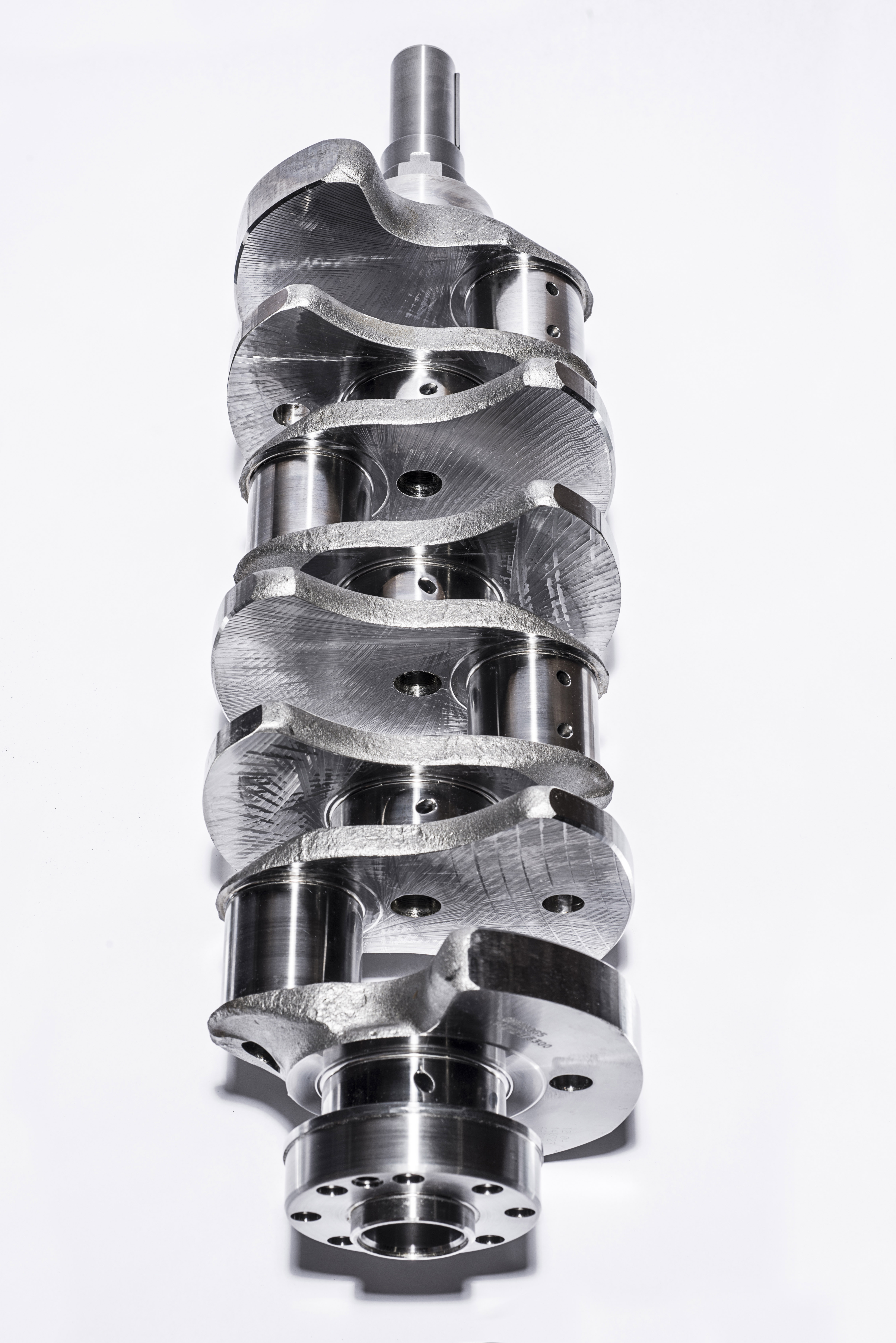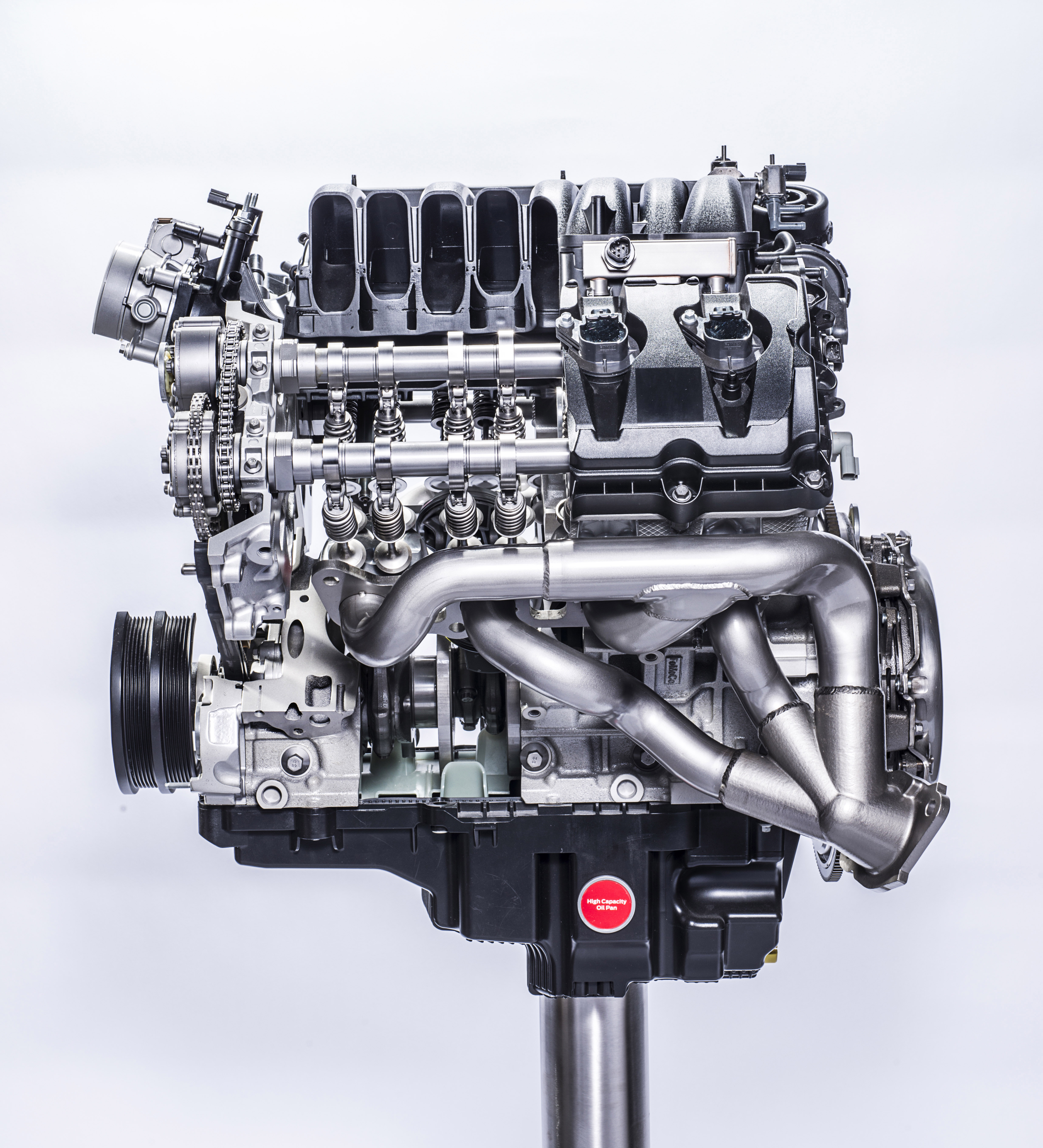For years the flat-plane-crankshaft V8 has been found in Ferraris and other Euro-exotics, primarily because of their powerfully sonic, high-revving, highly extroverted character. Now Ford offers one in a higher volume and more affordable iconic American sports coupe, the $56,495 2016 Ford Shelby Mustang GT350 and track-focused $63,995 GT350R.
Essentially all new, the 5.2-liter in the Shelby is not a derivation of the 5.0L V-8 available in other Mustang models. "Only the valve keepers and keys, a rear seal retainer and some fasteners are shared with any other Ford V-8," says Eric Ladner, its chief engineer. "Different bores, water jackets and head bolts drove us to a new block, and the crankshaft, rods, bearings, cylinder heads, intake and exhaust valves, oil pan, pick-up tube, gaskets and rear crank seal are unique."
Though larger in displacement than the 5.0L and 20 percent more powerful, the new engine is a significant 13 pounds lighter. It also has higher compression (12.0:1 vs 11.0:1), 10 percent higher volumetric efficiency, lower friction, and an amazing 8,250-rpm redline. The maximum revs and the high levels of airflow the engine requires are the major reasons for its unique (for a non-exotic) flat-plane crank.
 The 5.2L V-8 team's targets began with those of the car for which it was designed, "a serious track car that is street capable as well," Ladner relates. "Discussions were around light weight and high performance, not just power but the broadness of the torque curve and power band, especially in the range where it will be used on the track."
The 5.2L V-8 team's targets began with those of the car for which it was designed, "a serious track car that is street capable as well," Ladner relates. "Discussions were around light weight and high performance, not just power but the broadness of the torque curve and power band, especially in the range where it will be used on the track."
The initial targets were 500 hp at a 7,500-rpm power peak and 410 ft.-lb. of torque at 4,750 rpm. "Then, pushing and stretching ourselves, we looked at 100 hp per liter and revised the target to that. Then we overachieved and delivered 526 hp at 7,500 rpm and 429 ft.-lb. (582 Nm) at 4,750. Our original target for engine speed was 8,000 RPM, then once we built hardware and tested and developed it, we verified that we could take that further out to the 8,250-rpm redline. And the power is pretty flat. It peaks at 7,500, then drops off very slowly."
During a track test of a GT350R at Michigan's Grattan Raceway, we were blown away by the flat-plane V-8's earthy animal yowl and its willingness to rev like a racing engine, which it essentially is. Even without the increasingly common technologies of direct fuel injection and turbo- or supercharging, it is easily Ford's most powerful and (at 102 ponies per liter) most power-dense naturally aspirated road-going engine ever. And it also blew away the editors of online industry magazine WardAuto World, which named it one of their 2016 10-Best Engines.
The old power-enhancing techniques of a high-flow intake manifold and long-tube exhaust headers can maximize flow, but long headers move the catalytic converters too far away for emissions-compliant light-off. The flat-plane crankshaft - which positions half of its eight pistons 180 degrees opposite the other half instead of 2 pistons every 90 degrees - effectively makes the engine's short-tube headers perform like long ones. And with big high-lift valves and a large 87-mm throttle body, Ladner says the 5.2L's intake and exhaust ports flow better than those of the Ferrari 458 flat-plane-crank V-8 it was benchmarked against.
One downside of a flat-plane crank, however, is significant vibration. "Lateral shaking forces are higher than we generally deal with," Ladner says. "We took into account the higher vibration levels as inputs to our CAE (computer-aided engineering) tools and testing, and our design verification plans also involved a number of hours of shaker-rig testing. We just went through the design process as we normally would for any engine, but at higher-level inputs."

While the engine team benchmarked the Ferrari 458's flat-plane-crank V-8 for performance, the vehicle team analyzed a front-engine Ferrari California with the same engine for NVH (noise, vibration, and harshness). "We took measurements and looked at the parts and how they implemented some things," Ladner says. "I think we beat it." Yet there is still a need for some bracing on the car's underbody to minimize engine-driven shake.
The engine is assembled by two skilled builders who follow it along a low-volume "niche" line in a separate building behind Ford's Romeo engine plant, then sign it when they're done. Ford built just 100 GT350 and 37 GT350Rs for 2015, the 50th anniversary of the original Shelby Mustang GT350, because that original 1965 run was 37. But for 2016, they are regular production models expected to total 3,000-5,000 a year.
Related Video:

Essentially all new, the 5.2-liter in the Shelby is not a derivation of the 5.0L V-8 available in other Mustang models. "Only the valve keepers and keys, a rear seal retainer and some fasteners are shared with any other Ford V-8," says Eric Ladner, its chief engineer. "Different bores, water jackets and head bolts drove us to a new block, and the crankshaft, rods, bearings, cylinder heads, intake and exhaust valves, oil pan, pick-up tube, gaskets and rear crank seal are unique."
Though larger in displacement than the 5.0L and 20 percent more powerful, the new engine is a significant 13 pounds lighter. It also has higher compression (12.0:1 vs 11.0:1), 10 percent higher volumetric efficiency, lower friction, and an amazing 8,250-rpm redline. The maximum revs and the high levels of airflow the engine requires are the major reasons for its unique (for a non-exotic) flat-plane crank.
 The 5.2L V-8 team's targets began with those of the car for which it was designed, "a serious track car that is street capable as well," Ladner relates. "Discussions were around light weight and high performance, not just power but the broadness of the torque curve and power band, especially in the range where it will be used on the track."
The 5.2L V-8 team's targets began with those of the car for which it was designed, "a serious track car that is street capable as well," Ladner relates. "Discussions were around light weight and high performance, not just power but the broadness of the torque curve and power band, especially in the range where it will be used on the track."
The initial targets were 500 hp at a 7,500-rpm power peak and 410 ft.-lb. of torque at 4,750 rpm. "Then, pushing and stretching ourselves, we looked at 100 hp per liter and revised the target to that. Then we overachieved and delivered 526 hp at 7,500 rpm and 429 ft.-lb. (582 Nm) at 4,750. Our original target for engine speed was 8,000 RPM, then once we built hardware and tested and developed it, we verified that we could take that further out to the 8,250-rpm redline. And the power is pretty flat. It peaks at 7,500, then drops off very slowly."
During a track test of a GT350R at Michigan's Grattan Raceway, we were blown away by the flat-plane V-8's earthy animal yowl and its willingness to rev like a racing engine, which it essentially is. Even without the increasingly common technologies of direct fuel injection and turbo- or supercharging, it is easily Ford's most powerful and (at 102 ponies per liter) most power-dense naturally aspirated road-going engine ever. And it also blew away the editors of online industry magazine WardAuto World, which named it one of their 2016 10-Best Engines.
The old power-enhancing techniques of a high-flow intake manifold and long-tube exhaust headers can maximize flow, but long headers move the catalytic converters too far away for emissions-compliant light-off. The flat-plane crankshaft - which positions half of its eight pistons 180 degrees opposite the other half instead of 2 pistons every 90 degrees - effectively makes the engine's short-tube headers perform like long ones. And with big high-lift valves and a large 87-mm throttle body, Ladner says the 5.2L's intake and exhaust ports flow better than those of the Ferrari 458 flat-plane-crank V-8 it was benchmarked against.
One downside of a flat-plane crank, however, is significant vibration. "Lateral shaking forces are higher than we generally deal with," Ladner says. "We took into account the higher vibration levels as inputs to our CAE (computer-aided engineering) tools and testing, and our design verification plans also involved a number of hours of shaker-rig testing. We just went through the design process as we normally would for any engine, but at higher-level inputs."

While the engine team benchmarked the Ferrari 458's flat-plane-crank V-8 for performance, the vehicle team analyzed a front-engine Ferrari California with the same engine for NVH (noise, vibration, and harshness). "We took measurements and looked at the parts and how they implemented some things," Ladner says. "I think we beat it." Yet there is still a need for some bracing on the car's underbody to minimize engine-driven shake.
The engine is assembled by two skilled builders who follow it along a low-volume "niche" line in a separate building behind Ford's Romeo engine plant, then sign it when they're done. Ford built just 100 GT350 and 37 GT350Rs for 2015, the 50th anniversary of the original Shelby Mustang GT350, because that original 1965 run was 37. But for 2016, they are regular production models expected to total 3,000-5,000 a year.
Related Video:











Sign in to post
Please sign in to leave a comment.
Continue